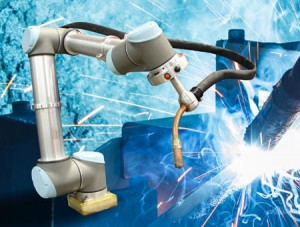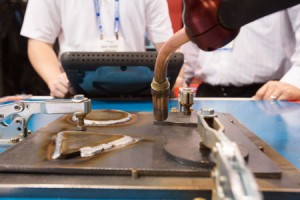Lightweight Universal Robots take on heavy duty welding
 Sure, cobots are lightweight: the largest UR10 robot is under 29kg, so they’re easy to pick up and move from one process to another. But they’re no lightweights when it comes to heavy-duty processes like welding. In fact, there’s already a range of cobot welding systems to choose from. Surprised? Don’t be. It’s just one more smart application for these flexible, cost-effective, and easy-to-program automation tools.
Sure, cobots are lightweight: the largest UR10 robot is under 29kg, so they’re easy to pick up and move from one process to another. But they’re no lightweights when it comes to heavy-duty processes like welding. In fact, there’s already a range of cobot welding systems to choose from. Surprised? Don’t be. It’s just one more smart application for these flexible, cost-effective, and easy-to-program automation tools.
The flexibility and ease-of-programming of cobot-based welding systems make them especially well-suited for low-volume/high-mix environments, as well as custom or small-template welding processes. But with high accuracy and repeatability, these systems can also handle long runs with consistent quality. Welding tasks can be programmed in as little as half-an-hour by workers who have no previous experience, and programs can be saved and reused, saving the expense of trained robot programmers. Lightweight cobot welders can be mounted on tabletops, hung from ceilings, or installed into existing welding booths, offering more flexibility than manual welders or traditional fixed robots. Several companies have already announced cobot welding systems.
Universal Robots (UR) and ARC Specialties recently announced the first collaborative MIG welding system in the US. The SnapWeld Collaborative Robot Welding package is a cobot-assisted, interactive welding system that can be deployed in existing, manual welding booths, so it eliminates the need for costly new robotic cells. The system is ideal for small job shops that are struggling with the budget, programming, and space requirements of traditional welding robots.
The SnapWeld system includes a Profax wire feeder and water-cooled torch for welds up to 600 amps, along with the UR robot. One of the big advantages of using cobots for a welding application is the ease of programming. SnapWeld was developed with and verified by Universal Robots through the UR+ platform facilitating direct software integration into the UR programming environment, enabling advanced settings to be easily programmed directly on the robot’s teach pendant.
“We are getting a lot of requests for integrating Universal Robots in welding booths, so we saw this as a unique opportunity to develop an integrated low-cost system for gas metal arc welding (GMAW) applications that no one else in the market is currently offering,” says John Martin, Vice President of ARC Specialties, a Certified Systems Integrator of UR robots.
Settings include features such as wire-feed speed and burn-back time, gas-flow time, and crater-fill time with instant feedback on welding volts and amps. The result is a fully integrated, low-cost system for gas metal arc welding (GMAW) applications that is ideal for low-volume/high-mix shops.
Another cobot welding system, the CoWelder, is available from Migatronic in Denmark. The CoWelder system includes a UR5 or UR10 robot—depending on payload and reach requirements—along with a Migatronic power source, start/stop safety box, and Migatronic welding torch and torch holder.
 The system fits on a tabletop, making it ideal for even the smallest shops, with simple set-up and programming for significant savings over traditional complex robotic systems. The robotic welder ensures uniformity in series production, but it is so fast and easy to reprogram that it provides value even for small batches. For high-mix situations, shops can build a library of programs for different workpieces and easily switch among them during a workday.
The system fits on a tabletop, making it ideal for even the smallest shops, with simple set-up and programming for significant savings over traditional complex robotic systems. The robotic welder ensures uniformity in series production, but it is so fast and easy to reprogram that it provides value even for small batches. For high-mix situations, shops can build a library of programs for different workpieces and easily switch among them during a workday.
Migatronic customer Sebastian Jacobsen, Project Manager at Jyden Bur A/S, Denmark says, “We can program new workpieces in no time. It really only takes 30 minutes for us to program a new workpiece and a few seconds to recall already stored programs. I don’t think it can get any easier.”
Speaking of productivity gains, Jens Christian Lægsgaard, General Manager of MVI Maskinfabrik in Denmark says, “Our time saved per workpiece is about 50%. We produce from ten to 1000 workpieces at a time. Our efficiency gains are 30-40% owing to the easy switching between programs and welded workpieces. And this is just the beginning.”
As integrators look to provide high-ROI automation solutions, welding is a clear target. And integrators around the world are looking first to UR for the cobots to power their collaborative welding systems. Additional solutions have been announced from the Dutch integrator Cobot Automation and US-based SCOTT Automation (parent company of RobotWorx).
Visit the Universal Robots website for more information
See all stories for Universal Robots















